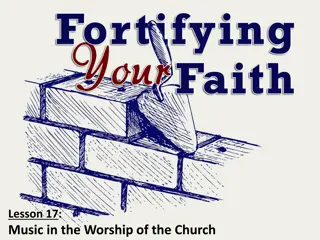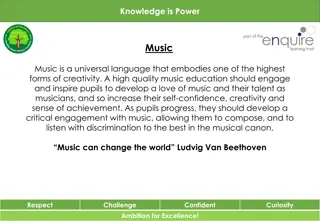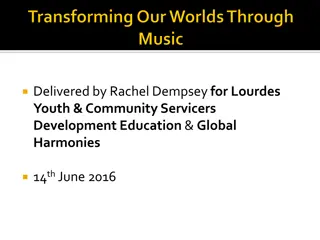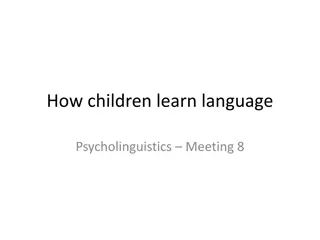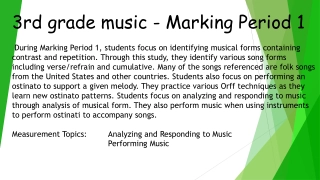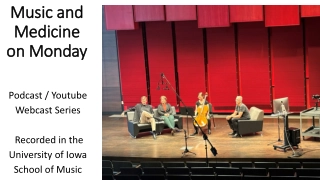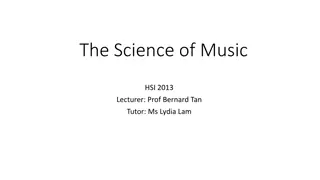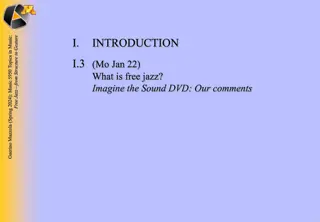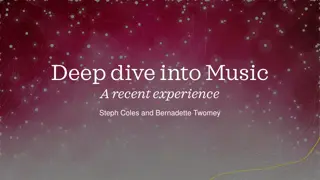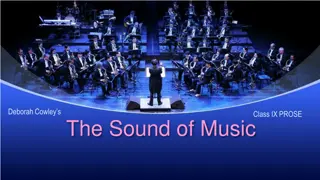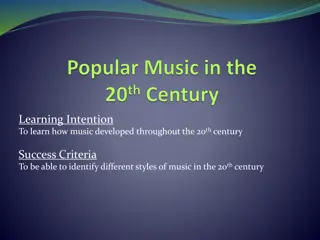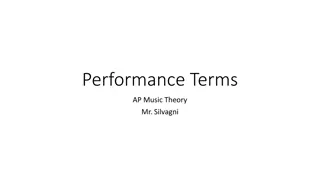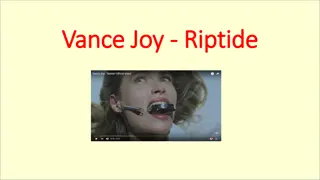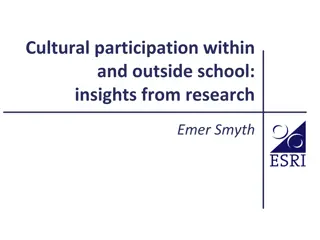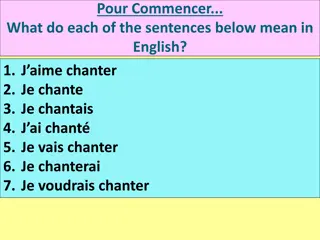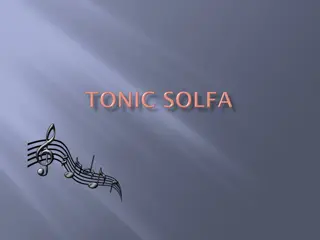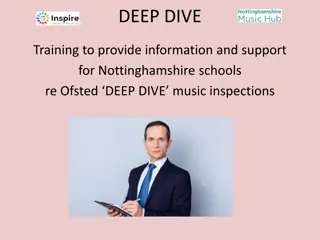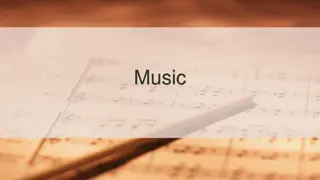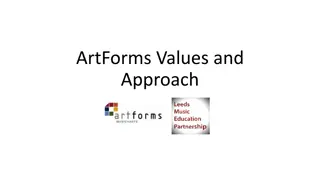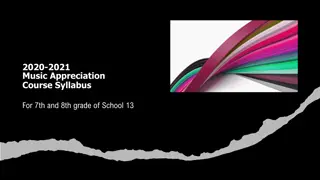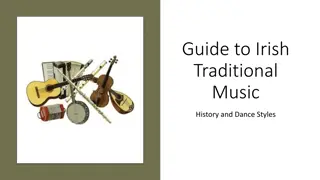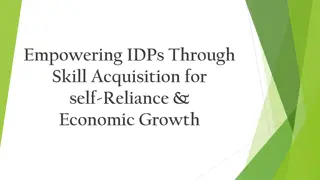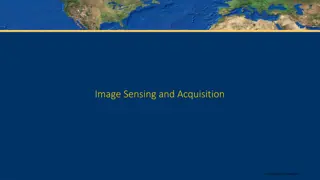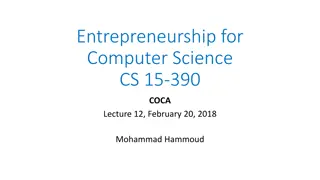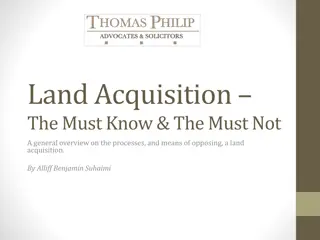The Power of Music in Second Language Acquisition
Enhancing second language acquisition through music offers numerous benefits such as improved pronunciation, vocabulary expansion, cultural understanding, and enhanced motivation. Music activates brain regions vital for learning and memory, releases dopamine to improve mood, and provides a portable learning tool. Incorporating songs into language lessons promotes authentic language practice and fosters a positive learning experience.
Download Presentation

Please find below an Image/Link to download the presentation.
The content on the website is provided AS IS for your information and personal use only. It may not be sold, licensed, or shared on other websites without obtaining consent from the author. Download presentation by click this link. If you encounter any issues during the download, it is possible that the publisher has removed the file from their server.
E N D
Presentation Transcript
USING MUSIC TO ENHANCE SECOND LANGUAGE ACQUISITION: FROM THEORY SATEAL Conference University of Edinburgh 17thMarch 2018 Silvia Fiddes Ortiz Perea EAL Aberdeenshire Council TO PRACTICE.
MUSIC AND SECOND LANGUAGE ACQUISITION Introduction and Background Troubadours and minstrels Chants/adverts From an early age, music and songs in the form of nursery rhymes are encouraged by the Scottish Government in junction with the Scottish Book Trust, Bookbug program in local libraries Jolly Phonics Music Box and Abricabeats Baker (2014) in his A Parent s and Teacher s Guide to Bilingualism states: Children singing nursery rhymes or acting out a folk tale are not only learning language, enjoying the drama and having fun, they are also picking up part of the culture allied to the language. The language is becoming anchored
MUSIC AND SECOND LANGUAGE ACQUISITION: BENEFITS AND ADVANTAGES Songs enhance the receptive skills as well as the skills within the skills, traditionally listed as pronunciation, extent of vocabulary, correctness of grammar, the ability to convey exact meaning in different situations and variations in style Phonetics, History and culture Learning the lyrics of a song helps you expand your vocabulary and teach you slang, typical phrases, grammar and idiomatic sentences among other things Singing can actually help you to reduce your foreign-sounding accent and teach you about different accents making Phonetics easier Music connects across cultures and generations plus it can break down barriers (Ice breaker in class/ blog) Motivation is a pivotal factor when teaching a second language (Baker/Krashen)
MUSIC AND SECOND LANGUAGE ACQUISITION: BENEFITS AND ADVANTAGES Music activates certain regions in your brain which are involved in movement, planning, attention, learning and memory (dementia patients) Music releases a chemical in your brain called dopamine, which improves your mood and reduces anxiety. It also induces pleasure, joy and motivation creating positive emotional experiences. Another advantage of using music in your lessons is that you can take music with you anywhere and learn and practice it on the move thanks to your MP3 player/Ipad/ mobile phone/ internet access. Using songs provide a valuable source of authentic language and there are hundreds of ways to exploit them in the classroom (Life performance by John Langan)
HOW I CLASSIFY SONGS SO THAT THEY BECOME EFFECTIVE ENGLISH LANGUAGE LEARNING TOOLS+ ACTIVITIES
What does the learner bring to the task? What are the task demands? What additional support needs to be planned? Social The students have experience of listening songs in English and collaborative performing games/activities. The students will need to be motivated by music and they should enjoy this type of tasks using songs they will be able to play and remember later. Encourage the students to take part and include all in the group and activities. Cognitive The student have an understanding of the instructions and the development of the tasks related to the songs. The questions/activities will require the students to use their knowledge and their background knowledge of English when listening to songs. Provide/ adapt lyrics and questions depending on the group level/student level you are teaching to. Set activities at the cognitive level of the student. Linguistic The students are familiar with the language of the activities instructions: Fill the gaps, bingo cards, karaoke, lip sync, guessing titles, names of programs/apps used to create music videos etc. The students will need to read the activities and questions. They will need sufficient communication skills in English to discuss the task, songs and vocabulary. Ensure the bilingual students are working with peers who have a working understanding of the lyrics vocabulary and grammar. The students have strategies for reading/listening familiar and unfamiliar vocabulary. The students are happy
GROUP 1: SONGS AND MUSIC THAT CONTAINS A LOT OF USEFUL VOCABULARY, PHRASES AND EXPRESSIONS. Technologic by Daft Punk used to teach vocabulary about technology and computers. https://www.youtube.com/watch?v=YtdWHFwmd2o Hand In My Pocket by Alanis Morrisette. Ideal to teach adjectives https://www.youtube.com/watch?v=aTgrASzzUXU Friday I m In Love by The Cure, teaching days of the weeks and adjectives related to feelings. https://www.youtube.com/watch?v=k5eKciJisnI Paint It Black by The Rolling Stones (Dark semantic fields) https://www.youtube.com/watch?v=O4irXQhgMqg&list=RDO4irXQhgMqg Once I Was by Tim Buckley to teach occupations in a basic level or past simple expressions in a more advanced level. https://www.youtube.com/watch?v=eNUdbgPBDqU
GROUP 2: SONGS AND MUSIC WHICH CAN TEACH GRAMMAR. Numb by U2 teaching verbs and commands like don t . And words which rhyme with ape https://www.youtube.com/watch?v=-e1Rn1cItvc I Still Haven t Found What I Am Looking For by U2 to teach Present Perfect https://www.youtube.com/watch?v=5vye_tNZYL8 My Girl by The Temptations to teach School subjects and repetitive structures. https://www.youtube.com/watch?v=6IUG-9jZD-g Yellow by Coldplay to teach past simple https://www.youtube.com/watch?v=yKNxeF4KMsY That I Would Be Good by Alanis Morrisette. You can use this song to teach conditional tense and the even if as a subordinate conjunction. https://www.youtube.com/watch?v=MMt3_p04XaQ
GROUP 3: SONGS AND MUSIC WHICH HELP THE STUDENT GET FAMILIAR WITH PHONETICS AND DIFFERENT ACCENTS/DIALECTS. Listening to songs will also allow you to focus on your pronunciation and understanding of the English language s rhythm, tone and accents. Jock O' Braidislee the Corries https://www.youtube.com/watch?v=v15wEsHg3gY Wha Widna Fecht For Charlie by The Corries (Jacobite Rebellion to teach Scots language and History) https://www.youtube.com/watch?v=dXzDdDFfAA8&list=PLAEA7D750B5002C1F Auld Lang Syne Original by Robert Burns * It can be used translating into English https://www.youtube.com/watch?v=wPnhaGWBnys I used this Elvis Presley song In the Ghetto sang by a Spanish gipsy called El Principe Gitano so that students could see how not to pronounce English and 1st language interference in phonemes occurs sometimes. https://www.youtube.com/watch?v=QrTfYItDDwA vs In the Ghetto by Elvis https://www.youtube.com/watch?v=2_lwq-T_Ltc
GROUP 4 MUSIC WHICH TEACHES (ENGLISH/AMERICAN/SCOTTISH/IRISH) CULTURE/POLITICS Iron Sky by Paolo Nutini (Scottish Referendum 2014) https://www.youtube.com/watch?v=DMiAZfeVohI Sunday Bloody Sunday by U2 (Bloody Sunday in Belfast) https://www.youtube.com/watch?v=LQZLPV6xcHI Pride by U2 (Martin Luther King) https://www.youtube.com/watch?v=ByuyP1PNqKQ No Woman No Cry by Bob Marley No Woman, No Cry" is a reference to England s prior control of Jamaica. Woman" is a reference to the Queen of England. They used to protest in Trench Town all night long against England. A purely political song. https://www.youtube.com/watch?v=mcTKcMzembk Born in the USA by Bruce Springteen on the negative effect of Vietnam War and the treatment of American veterans on their arrival back home. https://www.youtube.com/watch?v=OuJUq58VQXQ
American Pie by Don Mclean American History and events: http://www.bbc.co.uk/news/magazine-32196117 Letters From America by The Proclaimers (Scottish Immigration) https://www.youtube.com/watch?v=ZwYxZNbbAaA Flower of Scotland by The Corries (Scottish unofficial national anthem) https://www.youtube.com/watch?v=RPaJhlIIYjM Auld Lang Syne Original by Robert Burns * It can be used translating into English https://www.youtube.com/watch?v=wPnhaGWBnys English Man in New York by Sting to teach differences between American and British Culture https://www.youtube.com/watch?v=reghyn9fmJQ
41 Shotsby Bruce Springteen About the shooting of Amadou Diallo occurred on February 4, 1999, when Amadou Diallo, a 23-year-old immigrant from Guinea, was shot and killed by four New York City Police Department plain-clothed officers: Sean Carroll, Richard Murphy, Edward McMellon and Kenneth Boss. The officers fired a combined total of 41 shots, 19 of which struck Diallo, outside his apartment at 1157 Wheeler Avenue in the Sound view section of The Bronx. The four were part of the now-defunct Street Crimes Unit. All four officers were charged with second-degree murder and acquitted at trial in Albany, New York. Diallo was unarmed at the time of the shooting, and a firestorm of controversy erupted subsequent to the event as the circumstances of the shooting prompted outrage both within and outside New York City. Issues such as police brutality, racial profiling, and contagious shooting were central to the ensuing controversy. https://en.wikipedia.org/wiki/Shooting_of_Amadou_Diallo https://www.youtube.com/watch?v=aQMqWAiWPMs This song can be used to open a debate upon issues such as police brutality, racial profiling, and possession of arms in USA.
GROUP 5 SONGS THAT TEACH ABOUT LITERATURE/ LITERARY FIGURES. Ironic by Alanis Morrisette to teach irony/similes https://www.youtube.com/watch?v=Nm-1xvWibt0 The Lady of Shallot original poem by Poem by Alfred Lord Tennyson sang by Loreena Mckennitt https://www.youtube.com/watch?v=80-kp6RDl94 Greensleeves by Loreena Mckennit https://www.youtube.com/watch?v=N4rvcZMY37I In Shakespeare's The Merry Wives of Windsor (written c.1597; first published in 1602), the character Mistress Ford refers twice to "the tune of 'Greensleeves'", and Falstaff later exclaims: Let the sky rain potatoes! Let it thunder to the tune of 'Greensleeves'!
Romeo and Juliet by Dire Straits. https://www.youtube.com/watch?v=mxfjSnMN88U "Exit Music (For a Film)" by Radiohead is based on Shakespeare's Romeo & Juliet. https://www.youtube.com/watch?v=zzhepWIImj4 1984 by David Bowie in reference to George Orwell https://www.youtube.com/watch?v=aSv3KCOuJGc "The Ghost of Tom Joad" by Bruce Springsteen is about The Grapes of Wrath by John Steinbeck. https://www.youtube.com/watch?v=B-c6GphpAeY A Pict Song Lyrics by Rudyard Kipling, song by Billy Bragg. https://www.youtube.com/watch?v=cyuCjwyj1Hk
GROUP 6 SONGS THAT CAN BE FOUND IN DIFFERENT LANGUAGES Chiquitita https://www.youtube.com/watch?v=p4QqMKe3rwY https://www.youtube.com/watch?v=UAdQj_fPqAg and Fernando by Abba in English and Spanish https://www.youtube.com/watch?v=Xv_-6XQyIq0 https://www.youtube.com/watch?v=RbJlGHvuPO8 Fisherman s Blues by the Waterboys https://www.youtube.com/watch?v=DxtpRXGpWmw and El Blues del Pescador by Celtas Cortos. https://www.youtube.com/watch?v=F0L50iVYjqI Caravane Raphael Haroche in French and in Spanish English subtitles: https://www.youtube.com/watch?v=hNSkiqhnL2M https://www.youtube.com/watch?v=P7aftTWTAwg
GROUP 7 SONGS NARRATING A STORY. (YOUTUBE VIDEOS DESCRIPTION AND COMPREHENSION QUESTIONS) Runaway Train by Soul Asylum https://www.youtube.com/watch?v=Zf8n0rc1JHc Nothing Compares to You by Sinead O Connor. https://www.youtube.com/watch?v=zJEIJAPMPvI&list=RDzJEIJAPMPvI Fast Car by Tracy Chapman https://www.youtube.com/watch?v=uPoH6p2lTXs No Love Today by Chris Smither (also could be used for American English) https://www.youtube.com/watch?v=lKlF-JYsYNg John Taylor s Month Away by King Creosote https://www.youtube.com/watch?v=NqRF6UkW4iM
GROUP 8 MISCELLANEOUS: SONGS THAT ARE EMOTIONAL FOR YOU OR BRING YOU TO A TIME IN YOUR LIFE YOU WANT TO REMEMBER. Unchained Melody by the Righteous Brothers brings me to my teenager s years. https://www.youtube.com/watch?v=qiiyq2xrSI0 Creep by Radiohead brings me to my University local club when I studied at Nottingham University. https://www.youtube.com/watch?v=XFkzRNyygfk With or Without you by U2 My first ever song I learnt in English https://www.youtube.com/watch?v=EzeDqRhM09w
GROUP 9 SONGS RELATED TO A SEASON/ PERIOD OF THE YEAR (CHRISTMAS SONGS/CAROLS FOR EXAMPLE Burns day Green Grow the Rashes by Band of Burns https://www.youtube.com/watch?v=7Fn5n9nluEY Happy Christmas, War Is Over by John Lennon https://www.youtube.com/watch?v=oXaLu7bvke8 The Little Drummer Boy By Boney M https://www.youtube.com/watch?v=GU1QmT7hbLE And in Spanish El Tamborilero by Raphael: https://www.youtube.com/watch?v=sIjRW60Fqyc Here Comes The Sun by The Beatles. https://www.youtube.com/watch?v=xfMWJi4req4
GROUP 10 SONGS MUSIC AND TECHNOLOGY/APPS/PROGRAMS. Using songs combined with apps or programs such as the Widgit to create visual representation using symbols which describe the lyrics. This could be used for students with learning difficulties, very early stages of learning acquisition or silent period . Check out this project done by Aspects in Aberdeenshire using the beginning of Abba s Take a Chance on Me https://www.youtube.com/watch?v=ogo2YaVsDE4&feature=youtu.be http://www.widgit.com/symbols/widgit_symbols.htm:
Students could also create their own video clips with Windows Movie Maker https://www.youtube.com/watch?v=l_Efky-cotY or an animation: Lemon Tree by Fools Garden: https://www.youtube.com/watch?v=XAFS43NKFag https://www.youtube.com/watch?v=hhaeXCUfKJA
DIFFERENT ACTIVITIES All these activities can be adapted to different levels from choosing basic words to more complex structures. Bingo cards: Selecting different items you want them to be focused upon to play bingo whilst listening to the song Filling gaps: The teacher selects the gaps of the items you are aiming to emphasise. If the students have not much English I suggest you get scaffolding and vocabulary support to digest the lyrics giving the students a chart with words they need to locate in the song. Title Guessing game: Use brain storm once you give them the title guessing game. What do you think is this song called about? Write a story with the plot of the song. Lip syncing talent show and Karaoke. (Some YouTube videos offer this possibility when lyrics are displayed)
Songs that tell stories are great for students to make comic strips out of. You have to choose your song carefully and spend time looking at the lyrics with the students and making sure they have understood the main ideas. Lower levels may need guidance as to how to divide up the song into suitable chucks that can be represented pictorially Create a movie maker video/animation Creating word clouds with vocabulary https://www.wordclouds.com/ http://www.freetech4teachers.com/2016/05/a-fun-tool-for-making-word-clouds-in.html#.V1wuXDUrLIU Order the verses: With low levels this is a very simple activity. Chop up the lyrics of the song by verse and give a small group of students the jumbled verses. As they listen they put them in order. Discussion: Certain songs lend themselves to discussions and you can use the song as a nice lead in to the topic and a way to pre-teach some of the vocabulary. Translation: Although some teachers oppose all use of the mother tongue in the language classroom, some students really enjoy translating lyrics into their own language. If you do ask students to do this ensure the lyrics are worth translating! Write the next verse: Higher levels can write a new verse to add to a song. Focus on the patterns and rhyme of the song as a group and then let students be creative. If they are successful, the new verses can be sung over the top of the original! Spot the mistakes Comic strip
REFERENCES AND BIBLIOGRAPHY Allen, J., & Vallette, E. (1977). Classroom teaching of foreign languages and English as a second language. Chicago: University of Chicago Press. Baker, C. (2007) Foundations of Bilingualism and Bilingual Education (4th Edition), Clevedon, Multilingual Matters. Baker, C. (2014) A Parents and Teachers Guide to Bilingualism (4th Edition) Bristol, Multilingual Matters. Baker, C. and Wright, W.E. (2017) Foundations of Bilingualism and Bilingual Education (6th Edition), Bristol, Multilingual Matters. Bartle, G. (1962). Music in the language classroom. Canadian Modern Language Review, Fall, 11-14. Caine, R. and Caine, G. (2011). Natural learning for a connected world: Education, technology and the human brain. New York, N.Y.: Teachers College Press. Cummins, J. (2000) Language Power and Pedagogy, Clevedon, Multilingual Matters. Dwayne. E Why Use Music in English Language Learning? A Survey of the Literature by English Language Teaching; Vol. 6, No. 2; 2013 ISSN 1916-4742 E-ISSN 1916-4750 Published by Canadian Center of Science and Education. Froehlich, J. (1985). Improving Aural Comprehension and Spelling through a Modified Cloze Procedure Using Songs and Poems. Die Unterrichtspraxis/Teaching German, 18(1), 49-54. http://dx.doi.org/10.2307/3529993 Gardner, H. (1993). Multiple Intelligences: The Theory in Practice. New York: Basic Books. Gardner, H. (1998). Reflections on Multiple Intelligences: Myths and Messages. In A. Woolfolk (Ed.) Readings in Educational Psychology. Boston: Allyn & Bacon. Gibbons, P. (1993) Learning to Learn in a Second Language. Portsmouth, NH: Heinemann Harmer, J. (1998) How to Teach English. Addison Wesley Longman Limited
Kanel, K. (2000). Songs in Language Teaching: Theory and Practice. Paper presented at The Proceedings of the JALT (Japan Association for Language Teaching) 25th Annual International Conference on Language Teaching & Learning and Educational Materials Expo, 69-75 Krashen, S. (1982). Principles and Practice in Second Language Acquisition. Oxford: Pergamon Press. Development Krashen, S.D. & Terrell, T.D. (1983). The Natural Approach: Language Acquisition in the Classroom. London: Prentice Hall Europe. Krashen, S. (1989). We acquire vocabulary and spelling by reading: Additional evidence for the input hypothesis. Modern Language Journal, 73 (4), 440-464. Learning and Teaching Scotland (2005) Learning in 2+ Languages. Education Scotland. Leith, W. (1979). Advanced French Conversation through Popular Music. The French Review, 52(4), 537-551. Lems, K. (2001). Using Music in the Adult ESL Classroom (1-4). Paper presented at National-Louis University. Medina, S. (1990). The effects of music upon second language vocabulary acquisition. Paper presented at the TESOL conference. San Francisco, CA. ED352834. Murphey, T. (1992). Music & Songs. Oxford University Press Odlin, T. (1986). Another Look at Passage Correction Tests. TESOL Quarterly, 20(1), 123-130. http://dx.doi.org/10.2307/3586394 Orlova, N. (2003). Helping Prospective EFL Teachers Learn How to Use Songs in Teaching Conversation Classes. The Internet TESL Journal, IX(3). Retrieved 20.12.2012 from http://iteslj.org/Techniques/Orlova-Songs.html
Oxford, R. (1990). Language Learning Strategies: What Every Teacher Should Know. Boston, Heinle and Heinle. Richards, J. (1969). Songs in Language Learning. TESOL Quarterly, 3(2), 161-174. http://dx.doi.org/10.2307/3586103 Salcedo, C (2010) The Effects Of Songs In The Foreign Language Classroom On Text Recall, Delayed Text Recall And Involuntary Mental Rehearsal. Journal of College Teaching & Learning Volume 7, Number 6, Southeastern Louisiana University, USA Saricoban, A., & Metin, E. (2000). Songs, Verse and Games for Teaching Grammar. The Internet TESL Journal, VI (10). Retrieved 20.12.2012 from http://iteslj.org/Techniques/Saricoban-Songs.html Segal, Beth, (2014) "Teaching English as a Second Language through Rap Music: A Curriculum for Secondary School Students" Master's Theses. Paper 104. Shaw, A. (1970). How to make Songs for Language Drill. English Language Teaching, 24(1), 125-132. http://dx.doi.org/10.1093/elt/XXIV.2.125 Sinclair, B. (1996). Learner autonomy and literature teaching. In Carter, C., & McRae, J. (eds.), Language, Literature and the Learner: Creative Classroom Practice (pp. 138-150). New York, Longman. Sch n, D., Boyer, M., Moreno, S., Besson, M., Peretz, I., & Kolinsky, R. (2008). Songs as an aid for language acquisition. Cognition 106(2), 975-983. http://dx.doi.org/10.1016/j.cognition.2007.03.005 Schunk, H. (1999). The Effect of Singing Paired with Signing on Receptive Vocabulary Skills of Elementary ESL Students. Journal of Music Therapy, XXXVI(2), 110-124. Techmeier, M. (1969). Music in the Teaching of French. The Modern Language Journal, 53(2), 96. http://dx.doi.org/10.1111/j.1540-4781.1969.tb04568.x Using music to enhance second language acquisition: From theory to practice. This article appeared in Lalas, J. & Lee, S. (2002). Suzanne L. Medina, Ph.D. Language, Literacy, and Academic Development for English language Learners. Pearson Educational Publishing.
Wong, P., & Perrachione, T. (2007). Learning pitch patterns in lexical identification by native English-speaking adults. Applied Psycholinguistics, 27, 565-585. http://dx.doi.org/10.1017/S0142716407070312 Wolfe, P. (2006). Brain-compatible learning: Fad or foundation? School Administrator, 63(11), 10. doi: 10.1016/j.cognition.2007.03.005 Interesting links: All lyrics are from www.azlyrics.com or www.metrolyrics.com http://www.scottishbooktrust.com/bookbug https://www.teachingenglish.org.uk/article/using-music-songs http://extension.uga.edu/publications/detail.cfm?number=C1053-06 http://blogs.scientificamerican.com/observations/the-science-of-earworms-or-why-you-cant-get-that-damn-song-out-of-your- head/ http://www.ncbi.nlm.nih.gov/pubmed/9090630 http://iafor.org/archives/journals/language-learning/4-Jane-K-Lartec-et-al.pdf The IAFOR Journal of Language Learning, Volume I - Issue I - Winter 2014




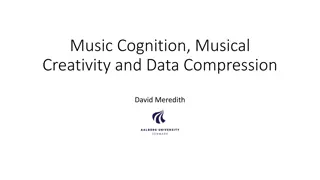
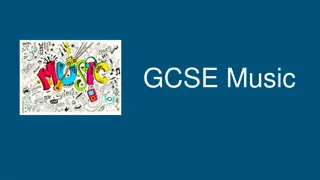
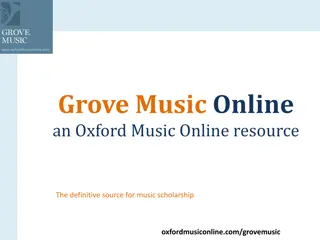
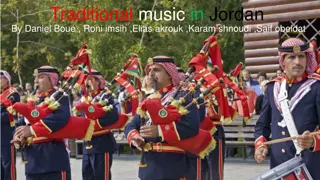

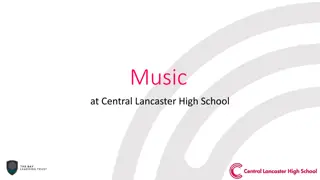
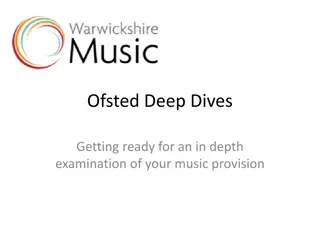
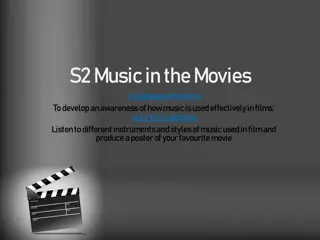
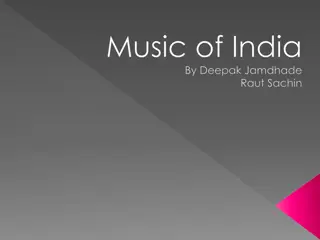
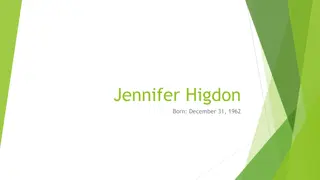
![Explore the Exciting World of Live Music Through [Insert Town/City] Census!](/thumb/148894/explore-the-exciting-world-of-live-music-through-insert-town-city-census.jpg)
